

Ruth & Joe's extended family vacation—gathering
at the Columbia River Gorge:
Amber, Lauren, Tim, Dena, Daddy, Mother, Anita, Brandon, Jay, Ruth, Joe, Mark
A week of long summer days in the Pacific Northwest—Washington and Oregon
Ruth's Picturesque Travelogue:
Joe and I took an extended family vacation the last week of June to see the states of Washington and Oregon. We flew into Seattle with my parents, my sister Anita and our brother-in-law Jay, their daughter Amber, and her husband Tim. We rented two cars, loaded them up, and headed to Lake Quinault, where we rented a cozy lakeside cabin two nights, taking temperate rainforest hiking excursions and exploring rugged ocean shorelines.
Hover the mouse over a picture for a caption. Click a photo or title to see a series in that set.
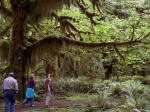 |
|
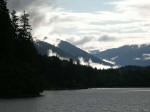 |
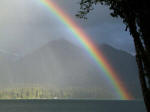 |
| Maple Glade Rain Forest Trail | Lake Quinault - First Sunrise | Lake Quinault - First Morning | Lake Quinault - Rainbow |
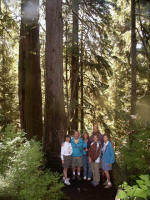 |
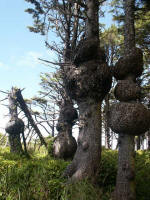 |
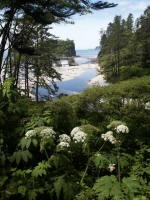 |
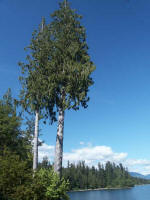 |
As much as we would have enjoyed staying the week on this gorgeous lake, we headed on south to visit my cousin Mark and his wife Dena, and their children, Lauren & newborn Brandon. Mark and Dena showed us the breath-taking Columbia River Gorge and some awesome waterfalls. Going to Portland, I saw a bald eagle sitting in a tree by the river. Mark and Dena hosted our whole crew with a scrumptious dinner to end a wonderful day, all celebrating together on my father’s 85th birthday in their beautiful home. We loved this, our first visit to their family and the gorgeous area they now call home. We’d like to fly into Portland and see them again!
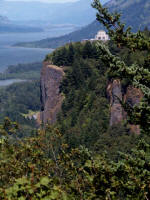 |
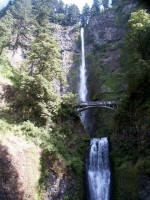 |
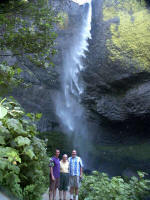 |
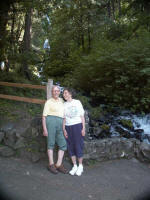 |
In the morning with Oregon’s Mount Hood in the rear-view mirror we headed to Mount St. Helens, and walked the volcanic eruption area with fascination. On the way to stay at our final destination, we made a supper stop in Chehalis at Spiffy’s—a restaurant we love!—and headed to the exquisite house we rented for the remainder of our week, nestled at the foot of Mount Rainier, our hiking pursuit for the next couple of days. The morning of our departure, the rain dissipated: we drove to Mount Rainier National Park a final time for a first close-up glimpse of the 14,411΄ snow-capped active volcano peak, thousands of feet higher than surrounding peaks and tallest of fifteen distinguished volcanoes that make up the backbone of the Cascade Range, including Mount St. Helens. The Northwest’s grandest mountain appears taller than mountains of comparable height, rising out of the earth at sea level, and holding the greatest single-peak glacial system in the United States of America.
[Spiffy's Restaurant, 110 Highway 12 (Exit 68), Chehalis WA 98532. (360) 262-3561]
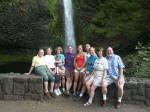 |
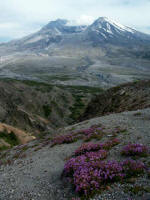 |
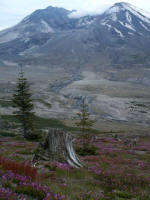 |
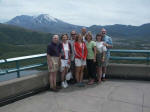 |
We want to see more of cutting-edge Oregon… and astonishing Washington, the only place in the world you can visit—like we did—a rainforest, a river gorge, volcanoes (we visited 2 of the 9), an ocean, numerous rivers, streams and lakes; and—what we didn’t visit in Washington during this week—two mountain ranges (we drove out along the jagged Olympics, and viewed the Cascades in-flight), a desert, wine country, and several islands.
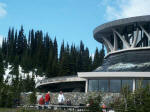 |
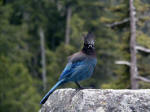 |
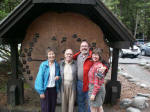 |
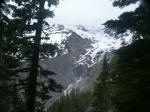 |
| Steller's Jay at Narada Falls | Longmire - Trail of the Shadows | ||
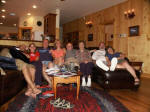 |
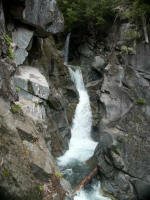 |
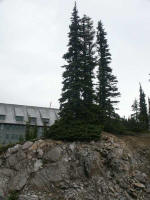 |
 |
| Christine Falls and Vicinity | Paradise Revisited |
Most browsers (like Internet Explorer) will display all of the 264 hover captions that accompany our 241 different pictures.
Photos and website by Ruth and Joe, and of our family by kind passers-by.
"We live in a beautiful country." —Daddy
Anita arranged the agenda and made the reservations.
Enjoy finding the names of Anita and Jay's four children and their spouses:
Amber and her husband Tim, Brian and his wife Sue, Jacob, and Katrina!
Their names enhance the content of the hover captions and paragraph text.
—Our
week-long extended family vacation 2007 portrayed in
poetry—
—
Ruth's Haiku
—
Pacific Northwest:
Gentle summer rain falls on
Active volcano.
Volcanoes and the Mountains: Lahars and the Boondocks
We liked looking at stream terraces (low-lying flat areas), the geologic depositional features built up by volcanic layers (not erosional features left “hanging”), that show two kinds of layers or deposits. The first results from river flooding: snowmelt with heavy rains or water backs up under the glaciers, and then releases quickly as a glacial outburst flood loaded with sand, gravel and boulders. A second kind of layer or deposit is composed of lahars (not lava flows) that form when sizable chunks of the volcano break off and travel downhill into a valley.
Anybody who knows anything about volcanoes may recognize lahar, an Indonesian word for volcanic mudflow, a flow of debris—not lava—often rich in clay material from rotten volcano rock containing soil, sand, gravel, & some vegetation (trees), all tumbled together and lubricated by a mix of melted snow and ice along with river water. Lahar got adopted into English from a 1920's study of volcanoes (and later of Mt. Merapi on the island of Java). Boondock (bundok, "mountain"), from the neighboring Philippine archipelago in the Pacific Rim, comes to enrich American vocabulary via Tagalog, one of the most important of the 109 languages in the Philippines.
In case you are not blessed by having part of your family come from the Philippines nor by a connection to the Pacific Northwest—diagonally across the country in the Piedmont, you score when it comes to cool volcanoes:
East in the Carolinas ancestral Appalachian volcano remnants remain; the Concord Pluton (Speedway Volcano, or, Concord Ring Dike), a partial, rather circular formation of igneous rock left when magma solidified well below the surface, is surrounded on three sides by syenite. What is left, exposed after erosion (located just east of UNC Charlotte, stretching northeast about six miles toward Concord), was several hundred million years ago the base of a volcano, about a mile underground. What is unusual, is the fractionation of tholeiitic magmas to produce syenite—and the absence of granitic—residua. The Appalachians no longer have lahars, but the long, complicated formation of the region yields a very complex geology, bounded in the east by the Brevard Fault with folded meta-sedimentary, meta-volcanic, & meta-plutonic rocks (like Looking Glass Rock pluton, a granite monolith by Brevard out in the boondocks of the Blue Ridge Mountains, in the beautiful Pisgah National Forest).
Links to a free on-line encyclopedia, (Wikipedia, die freie Enzyklopädie), in German:
Pazifischer
Nordwesten;
Columbia River
Gorge;
Mount St. Helens;
Mount-Rainier-Nationalpark.
Wikipedia is a
multilingual, non-profit, free content encyclopedia project. Its name
derives from Hawaiian wiki wiki ("quick"), and encyclopedia.